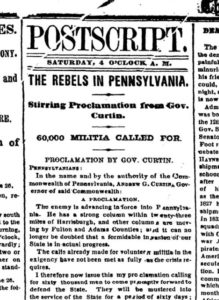As the Confederate Army began their march North in late June 1863, Pennsylvania Governor Andrew G. Curtin called for 60,000 militia volunteers to defend the state. Tens of thousands of Pennsylvanians signed up, mustering into 36 regiments, 4 battalions, and at least 10 companies of infantry, 4 battalions and 10 independent companies of cavalry, and 11 batteries of artillery.
One of the latter, of 6 guns, was formed by cadets at the Pennsylvania Military Academy in West Chester. They were initially rejected by Governor Curtin because of their youth, but the Academy president appealed on behalf of the older boys to the Governor, who accepted the battery for State service on 1 July 1863.
At least 4 cadets were among its leaders: George R. Guss (17) was commissioned Captain, Frank E. Townsend (20), First Lieutenant, John A. Leslie (19), First Sergeant, and William J. Harvey, Sergeant. It is perhaps not a coincidence that George’s father was Brigadier General Henry Ruhl Guss, formerly Colonel, 97th Pennsylvania Infantry.
Among the battery recruits was 20 year-old Private James S. Michener, late of Company C, 128th Pennsylvania Infantry. Michener had been wounded by a gunshot to the leg at Antietam on 17 September 1862 and discharged for disability in January 1863.
Apparently he’d recovered sufficiently by June to answer the Governor’s call.
Michener and the Battery were taken by rail to Carlisle near the capital, Harrisburg, and were posted there during and after the battle of Gettysburg, but saw no action. They were mustered out of service on 24 August 1862 once the danger was past.
The cadets returned to school, and James Michener became a civilian again.
_____________________
The cadets’ story from John A. Coulter’s Cadets on Campus: History of Military Schools of the United States (2017).
The newspaper clipping is from the New York Times of 27 June 1863.




Please Leave a Reply